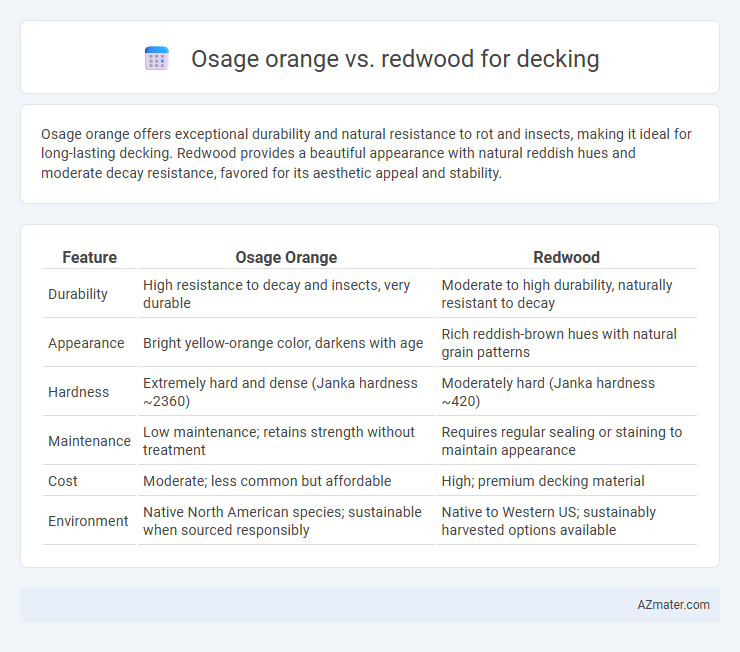Osage orange offers exceptional durability and natural resistance to rot and insects, making it ideal for long-lasting decking. Redwood provides a beautiful appearance with natural reddish hues and moderate decay resistance, favored for its aesthetic appeal and stability.
Table of Comparison
| Feature | Osage Orange | Redwood |
|---|---|---|
| Durability | High resistance to decay and insects, very durable | Moderate to high durability, naturally resistant to decay |
| Appearance | Bright yellow-orange color, darkens with age | Rich reddish-brown hues with natural grain patterns |
| Hardness | Extremely hard and dense (Janka hardness ~2360) | Moderately hard (Janka hardness ~420) |
| Maintenance | Low maintenance; retains strength without treatment | Requires regular sealing or staining to maintain appearance |
| Cost | Moderate; less common but affordable | High; premium decking material |
| Environment | Native North American species; sustainable when sourced responsibly | Native to Western US; sustainably harvested options available |
Introduction to Osage Orange and Redwood Decking
Osage Orange decking boasts exceptional durability and natural resistance to decay and insects, making it a strong contender for outdoor applications. Redwood decking is prized for its rich color, dimensional stability, and inherent resistance to moisture and rot, providing both beauty and longevity. Both woods offer unique aesthetic and functional benefits, with Osage Orange emphasizing hardness and longevity, while Redwood excels in visual appeal and weather resistance.
Wood Characteristics: Osage Orange vs Redwood
Osage Orange wood features exceptional density and natural rot resistance, making it highly durable for decking applications, while its bright yellow to orange hue darkens with age, offering a unique aesthetic. Redwood is prized for its straight grain and rich reddish-brown color, combined with inherent resistance to decay and insects, ensuring longevity in outdoor environments. Both woods provide excellent structural stability, but Osage Orange's hardness and toughness surpass Redwood, making it more resistant to dents and wear.
Durability and Lifespan Comparison
Osage orange offers exceptional durability with natural resistance to decay, insects, and weathering, boasting a lifespan of 25 to 40 years when properly maintained. Redwood, prized for its stability and resistance to moisture and insects, typically lasts around 15 to 30 years in outdoor decking applications. While Osage orange provides superior hardness and longevity, redwood's dimensional stability and aesthetic appeal remain popular choices for decking projects.
Resistance to Rot, Decay, and Insects
Osage orange offers exceptional resistance to rot, decay, and insect damage due to its dense, oily heartwood, making it a durable choice for decking in harsh environments. Redwood also provides strong natural resistance because of its high tannin content, which helps protect against fungal attacks and insect infestations, especially in outdoor applications. When comparing both, Osage orange tends to outperform redwood in longevity and structural integrity under prolonged exposure to moisture and pests.
Maintenance Requirements for Each Wood
Osage orange requires minimal maintenance due to its natural resistance to rot, insects, and decay, making it an excellent low-maintenance option for decking. Redwood, while also durable and resistant to decay, needs regular sealing or staining to maintain its vibrant color and protect against weathering over time. Both woods benefit from periodic cleaning, but Osage orange generally demands less upkeep, reducing long-term maintenance efforts and costs.
Appearance and Aesthetic Differences
Osage orange features a vibrant yellow-orange hue that darkens to a rich golden brown over time, with a fine, uniform grain and occasional knotty character, offering a warm and rustic aesthetic for decking. Redwood displays a striking reddish-brown color with prominent grain patterns and natural luster, providing a classic, elegant appearance favored in luxury outdoor spaces. Both woods age uniquely, with Osage orange developing a deeper patina and redwood maintaining its rich, reddish tone when treated properly.
Cost and Budget Considerations
Osage orange offers a durable, budget-friendly option for decking with its natural resistance to decay and insect damage, often costing less than premium hardwoods like redwood. Redwood, while more expensive upfront, provides exceptional aesthetic appeal and longevity, potentially reducing maintenance costs over time. Homeowners should weigh initial material costs against long-term durability and maintenance expenses to determine the best value for their decking project.
Environmental Impact and Sustainability
Osage orange offers an environmentally friendly option for decking due to its rapid growth and renewability, reducing deforestation pressure compared to slower-growing Redwood. Redwood, while durable and resistant to decay, often involves harvesting old-growth trees, raising concerns about habitat loss and carbon sequestration impact. Choosing Osage orange supports sustainable forestry practices and lower carbon footprints, making it a preferable eco-conscious decking material.
Installation Challenges and Tips
Osage orange decking requires careful handling due to its high density and hardness, which can make cutting and fastening more difficult compared to redwood. Pre-drilling screw holes is essential to prevent splitting, and using corrosion-resistant fasteners ensures durability against Osage orange's natural oils. Redwood offers easier installation with softer wood fibers but still benefits from pre-drilling, while its natural resistance to decay reduces maintenance needs over time.
Verdict: Which Wood is Best for Your Deck?
Osage orange offers exceptional durability and natural resistance to insects and decay, making it a low-maintenance choice for decking in harsh climates. Redwood provides a striking aesthetic with its rich color and smooth grain while offering moderate decay resistance and stability for long-lasting decks. Choose Osage orange for maximum toughness and longevity, or select redwood if visual appeal and ease of workability are your top priorities.

Infographic: Osage orange vs Redwood for Decking
 azmater.com
azmater.com